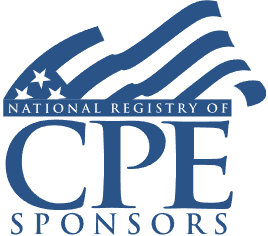Reviewing a Client's Estate Plan: Asset Disposition Under Wills and Trusts, Naming Fiduciaries, and Proper Asset Titling and Dispositions for CPAs and Other Advisers

Course Details
- smart_display Format
On-Demand
- signal_cellular_alt Difficulty Level
Intermediate
- work Practice Area
Tax Preparer
- event Date
Wednesday, December 18, 2024
- schedule Time
1:00 p.m. ET./10:00 a.m. PT
- timer Program Length
110 minutes
-
BARBRI is a NASBA CPE sponsor and this 110-minute webinar is accredited for 2.0 CPE credits.
-
BARBRI is an IRS-approved continuing education provider offering certified courses for Enrolled Agents (EA) and Tax Return Preparers (RTRP).
This webinar will detail components of an estate plan that should be reviewed regularly. Our panel of experts in estate planning and administration will cover interpreting estate planning documents, examining asset titling, methods of conveying assets, naming fiduciaries, and the role of trusts in managing bequests for practitioners working with high net worth individuals.
Faculty

Mr. Weeg, partner with Comiter Singer, is Board Certified in both Tax Law and in Wills, Trusts and Estates and is also a licensed CPA. His law practice includes drafting wills and trusts; advising on income, gift, estate, and GST tax issues; forming business and nonprofit entities; and probating estates. Mr. Weeg is experienced in the preparation of gift and estate tax returns, representation of executors in all phases of estate administration, and creating comprehensive estate plans tailored to meet clients’ personal objectives in a tax efficient manner. He is licensed to practice law in Florida and Texas.

Ms. Fukuto is a Tax Partner and specializes in the Estate and Trust Tax Services for Eide Bailly, LLP, a certified public accounting firm. With over 40 years of experience, she provides tax compliance, planning and consulting services for high net worth individuals, business succession and perpetuation planning for closely-held businesses and non-profit organizations. Ms. Fukuto's expertise includes estate and trust plan review and development, implementation and administration, tax compliance and strategic consulting services that allow her to work with complex estates and family wealth transfer issues. She obtained her Bachelor of Science in Accounting from the University of Southern California and her Masters degree in Taxation from Golden Gate University. Ms. Fukuto is a member of the American Institute of Certified Public Accountants and the California Society of Certified Public Accountants. She is also the Former Chair for the Orange County Estate Planning Council and Former Chair of the State Estate Planning Interest Group for the California Society of Certified Public Accountants.
Description
An estate plan can be generally boiled down into two components: asset disposition and naming fiduciaries.
As to the first component, estate planning lawyers assist clients with designing and drafting an estate plan that disposes of assets in accordance with the client's wishes upon death. After the plan is executed, the lawyer will finalize the engagement by advising on asset titling and beneficiary designations in order to implement the estate plan. The client's team of other advisers, such as the CPA, wealth manager, and life insurance professional, should assist with periodic reviews of the client's balance sheet and estate plan to ensure assets will pass in an efficient manner and in accordance with the client's wishes. To this end, each asset should be identified and examined to determine that it is properly titled and in sync with the estate plan. Gathering all the necessary documents can be a monumental task. Estate planning documents (wills and trust agreements), beneficiary designation forms, signature cards and account statements, deeds, and closely held entities are some of the documents that advisers must review. Assets should be separated into categories, including probate and non-probate, real and personal property, tangible and intangible, and U.S.-situs and international.
As to the second component, naming fiduciaries can be one of the most difficult decisions for clients. Fiduciaries are individuals or banks (known as "corporate trustees") tasked with the important duties of managing a person's affairs typically during a period of one's incapacity or administering trusts and estates for the benefit of the beneficiaries. Advisers can aid clients in reviewing these designations to confirm the named designations are still valid choices and have not otherwise gone "stale."
Wealth transfer professionals need to understand how to review a client's estate plan for oversights that could prove costly or delay the administration of an estate. Listen as our panel of estate planning experts explains how to review the key aspects of an estate plan.
Outline
- Reviewing a client's estate plan: introduction
- Titling and beneficiary designations
- Wills
- Class gifts and disposition of property
- Asset classes
- Revocable and irrevocable trusts
- Identifying fiduciaries
- Lifetime medical directives
- Other considerations
Benefits
The panel will review these and other critical issues:
- How asset titling affects an estate plan
- How life and legislative changes can disrupt a solid estate plan
- The types of fiduciaries and their roles in administering the estate
- Key questions to ask clients to ensure their assets will be properly transferred
NASBA Details
Learning Objectives
After completing this course, you will be able to:
- Recognize how asset titling affects an estate plan
- Identify the types of fiduciaries and their roles
- Determine how best to review a client's estate plan
- Distinguish between revocable and irrevocable trusts
- Identify the many uses for an irrevocable trust
- Differentiate between wills and trusts
- Field of Study: Taxes
- Level of Knowledge: Intermediate
- Advance Preparation: None
- Teaching Method: Seminar/Lecture
- Delivery Method: Group-Internet (via computer)
- Attendance Monitoring Method: Attendance is monitored electronically via a participant's PIN and through a series of attendance verification prompts displayed throughout the program
- Prerequisite: Three years+ business or public firm experience preparing complex tax forms and schedules, supervising other preparers or accountants. Specific knowledge and understanding of estate, gift and trust taxation including various trusts types, the unified credit, and portability.

Strafford Publications, Inc. is registered with the National Association of State Boards of Accountancy (NASBA) as a sponsor of continuing professional education on the National Registry of CPE Sponsors. State boards of Accountancy have final authority on the acceptance of individual courses for CPE Credits. Complaints regarding registered sponsons may be submitted to NASBA through its website: www.nasbaregistry.org.

Strafford is an IRS-approved continuing education provider offering certified courses for Enrolled Agents (EA) and Tax Return Preparers (RTRP).
Related Courses

Form 1041 Schedule D: Reporting Capital Gains for Trusts and Estates
Available On-Demand

Closer Connection Exception: Determining Tax Home; Treaty Tie-Breakers, Form 8840
Thursday, April 10, 2025
1:00 PM E.T.
Recommended Resources
How CPE Can Bridge the Gap Between What You Know and What You Need to Know
- Career Advancement